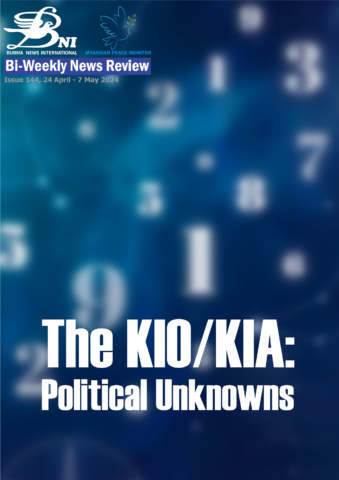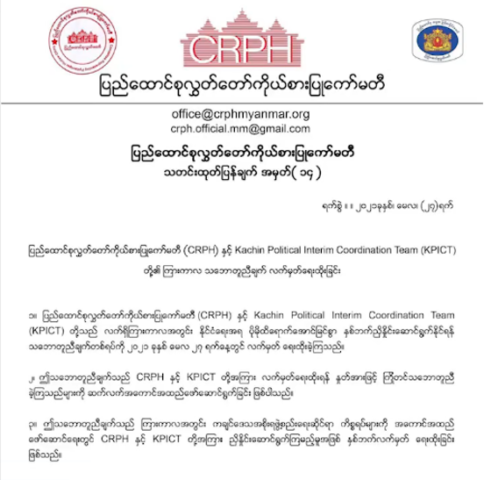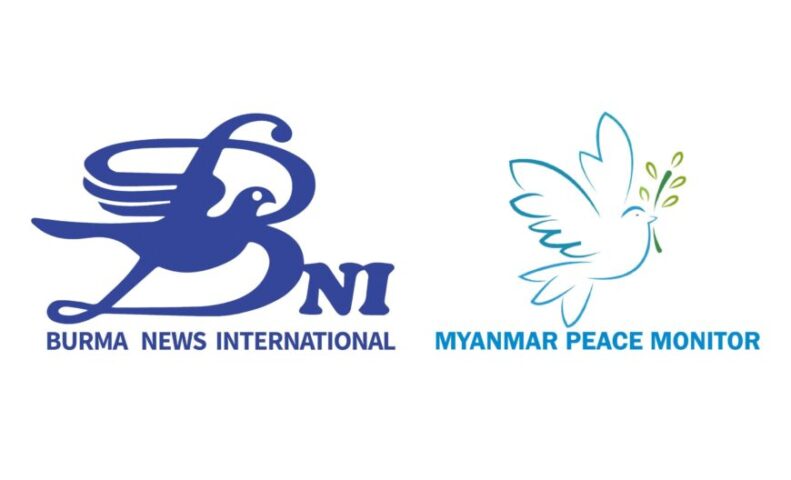
Introduction
The Kachin Independence Organization/Kachin Independence Army (KIO/KIA) took complete control of nearly 80 military junta bases and outposts in Kachin State over the past two months. The revolutionary journey of the KIO/KIA, which was founded in February 1961, has seen ups and downs. Although they reached a ceasefire with the military government on 24 February 1994, clashes with the military resumed on 9 June 2011 under the U Thein Sein administration. From then, the KIO/KIA continued to conduct offensives until 2013, but from late 2013 until 2020, the KIO/KIA halted all of its offensives and shifted to a defensive military strategy.
The ethnic resistance group considered the 1 February 2021 military coup led by Senior General Min Aung Hlaing as “unjust” and declared they would stand on the side of “justice”. KIO Chair General N’Ban La urged that the people must discern between “justice and injustice, truth and falsehood”. After the coup, the KIO/KIA also warned the military junta not to commit violence against civilians. Since then, the KIO/KIA’s military offensives against the junta have been observed. Despite this, the KIO/KIA’s role and political cooperation over the more than three years of the Spring Revolution have been surprisingly opaque.
Burma News International (BNI)-Myanmar Peace Monitor’s Bi-Weekly News Review this week examines the military offensives of the KIO/KIA and the political unknowns surrounding them along the Spring Revolution journey.
The KIO/KIA – Spearheaded Military Momentum
According to BNI-Myanmar Peace Monitor’s records, a total of 548 armed clash events occurred between the military junta and KIO/KIA-led allied forces as of 30 April 2024 after the military coup. Of these, over 160 clash events occurred in just the first four months of 2024, surpassing the number of clash events in each of 2021, 2022 and 2023. This indicates the highest intensity of the armed conflict so far. 1

By region, the KIO/KIA-led allied forces have carried out offensives against the junta troops in a total of 35 townships – 16 townships in Kachin State, 10 townships in northern Shan State, 8 townships in Sagaing Region and 1 township in Mandalay Region. As such, the number of townships where the KIO/KIA militarily operates has expanded by over 30 compared to 2019 and 2020 combined before the coup.
The resistance forces collaborating under the military leadership of the KIO/KIA include the Kachin People’s Defense Force (KPDF) in Kachin State and Mandalay Region, People’s Defense Force (PDF) battalions under the National Unity Government (NUG) in Sagaing Region, the All Burma Students’ Democratic Front (ABSDF), the United League of Arakan/Arakan Army (ULA/AA) and the Myanmar National Democratic Alliance Army (MNDAA) in northern Shan State. They have joined forces regionally to put pressure on the military junta’s troops. The collaboration between the KIO/KIA and NUG’s PDF battalions is clearly evident in the battle to capture Kawlin town in Sagaing Region on 6 November 2023.
At the same time, the KIO/KIA takes a leadership role in the Central Command and Coordination Committee (C3C) formed by the NUG Ministry of Defense and the four Ethnic Revolutionary Organizations (EROs) – Kachin Independence Organization/Kachin Independence Army (KIO/KIA), Karen National Union/Karen National Liberation Army (KNU/KNLA), Karenni National Progressive Party/Karenni Army (KNPP/KA), Chin National Front/Chin National Army (CNF/CNA) – dubbed as “K3C”. The KIO/KIA is currently spearheading operations in Regional Command 1, which covers Kachin State, Sagaing Region, Chin State, Shan State (North), Magway Region, and Mandalay Region.
Town/Outpost Seizures and Operation 0307
The KIO/KIA-led allied forces have so far seized control of six towns from the military junta – Injangyang in Kachin State on 20 November 2023, Maw Luu town of Indaw Township in Sagaing Region on 13 December 2023, Mabein town of Mansi Township in northern Shan State on 20 January 2024, Sinbo town of Myitkyina Township in Kachin State on 10 February 2024, Lwegel town on the China-Myanmar border on 29 March 2024, and Sumprabum in Kachin State on 5 May 2024. 2
Breaking down the 161 clash events between the KIO/KIA-led allied forces and the military junta’s troops in just the first four months of 2024 – there were 48 in January, 23 in February, 60 in March, and 30 in April, with March being the month with the highest intensity of fighting.
KIO/KIA information officer Colonel Naw Bu confirmed they took control of nearly 80 junta bases and outposts in these conflict events. Among them were strategically important junta positions along the swathes between Myitkyina and Lwegel, such as Seinlong, Yawyong, Lawmun, Lawdan, Shangtai, and Hpalang Bum, as well as the critically important military camp of Gi Don in Waingmaw Township. 3
In addition, the KIO/KIA-led allied forces have also been able to capture outposts that can pose threats to the security of Laiza, where the KIO headquarters is located, east of the Ayeyarwady River in Kachin State. These include Dawthponeyan-based Infantry Battalion-142, Ntap Bum, Shadan Pa (which has a helipad), Hpun Pyen Bum, and Masen Kawng. 4
As mentioned above, while the KIO/KIA’s offensives against the junta troops had intensified since the coup began in 2021, a spate of outpost captures starting around 7 March 2024 led to the emergence of a certain operation known as “Operation 0307”. This caused public speculations that the KIO/KIA and allies have launched a nationwide offensive.
Although the name “Operation 0307” and its objectives have not been officially announced, Colonel Naw Bu stated:
“This operation aims to get rid of all military council’s camps inside Kachin State.”
Tracing the political unknowns
While the Kachin Independence Organization/Kachin Independence Army’s (KIO/KIA) collaboration and leadership were prominently visible in marching alongside other resistance forces towards ending the military dictatorship, there are many political unknowns as to whether the ethnic armed organization has fallen behind in terms of political cooperation towards building a future federal democracy.
The KIO/KIA’s participation is not officially listed in the National Unity Consultative Council (NUCC), nor does the Kachin Political Interim Coordination Team (KPICT), which was formed to coordinate political affairs on behalf of the Kachin people within the NUCC, seem to lack full participation.

However, KPICT’s executive members and NUG’s Acting President Duwa Lashi La are still part of the National Unity Government (NUG). Moreover, KPICT still participates in the Transitional Constitution Working Group (TCWG) of the NUCC. News photos have occasionally emerged of NUG’s Defense Minister U Ye Mon conducting field visits alongside the KIO/KIA’s military leaders in conflict areas in Kachin State.
Therefore, in examining the political unknowns surrounding the KIO/KIA during the Spring Revolution, the signing of the “Interim Agreement” between the Committee Representing Pyidaungsu Hluttaw (CRPH) and KPICT on 27 May 2021 is intriguing.
The agreement, aimed at enabling more effective political coordination during the interim period, states: “They will continue to implement what has been verbally agreed upon between the two parties, and they have signed as a coordination principle for implementing matters related to the formation of the Kachin State government during the interim period.”
Since this agreement is understood to expire only after the interim period ends, the political coordination between the CRPH and KPICT for the formation of a “Kachin State Government” is presumed to still be in effect.
Therefore, the “verbally agreed upon matters” mentioned in the “Interim Agreement” remain political unknowns for both the KIO/KIA and KPICT regarding the Spring Revolution.
Nevertheless, while the Kachin People’s Defense Force (KPDF) has emerged under the KIO/KIA’s leadership in a united manner in Kachin State, it is notable that the People’s Defense Forces (PDFs), People’s Administration Teams, and People’s Security Teams, which are under the NUG and present in other states and regions, are absent in Kachin State. It remains to be seen whether the KIO/KIA’s ability to lead military, political, and administrative matters in Kachin State raises the political unknowns as to whether this could extend to the formation of a “Kachin State Government.”
Review
The offensives by the KIO/KIA and allied forces against the military regime forces are gaining steam. They have been able to capture towns such as Injangyang, Maw Luu, Mabein, Sinbo, Lwegel, and Sumprabum, and they have a very high chance of continuing to seize control of the economically and militarily significant cities connected to their territories.
The KIO/KIA’s participation in a leadership role, whether among the local resistance forces or in formations like the C3C (K3C+NUG), could continue to be active. Regarding the “Joint Position Statement” 5 issued on 31 January 2024 by the KNU, the KNPP, the CNF, and the NUG, the NUG’s Acting President Duwa Lashi La said:
“This joint position statement represents the points already strongly agreed upon among our allied ethnic organizations, the KIO, the KNU, the KNPP, and the CNF, which we call ‘K3C’. We need to continue to strive for further consensus among other allied ethnic organizations.”
The joint position statement outlines their vision, objectives, positions, and action plans for ending the military dictatorship and achieving a federal democratic union, in phases. Just as the political vision “to strengthen the stance that sovereign power derives from the people, and to end the dictatorship and build a genuine federal democratic union” is the purpose of the KPICT’s existence, this vision is highly unlikely to deviate from the KIO/KIA’s position and path. Under the C3C, the military leadership of the KIO/KIA is expected to be seen across Regional Command-1 (Kachin, Sagaing, Chin, Shan (North), Magway, and Mandalay), as well as in the northern and western regions of Myanmar. Despite the political unknowns surrounding the KIO/KIA regarding their participation in marching towards creation of a federal democratic union, their role may become more visible over time.
1 Myanmar Armed Conflict Dash board, BNI-MPM, 1 Feb 2021 – 30 April 2024
2 Map showing 56 resistance-controlled towns, BNI-MPM, 10 May 2024
3 Nearly 80 junta bases/outposts seized by KIA in two months of offensive, Myitkyina News Journal, 7 May 2024
4 Operation to drive out all junta forces blockading KIO headquarters, KNG, 11 March 2024
5 Joint position statement by allied organisations engaged in revolutionary struggle to wards annihilation of military dictatorship and establishment of a federal democratic union, NUG, 31 January 2024
